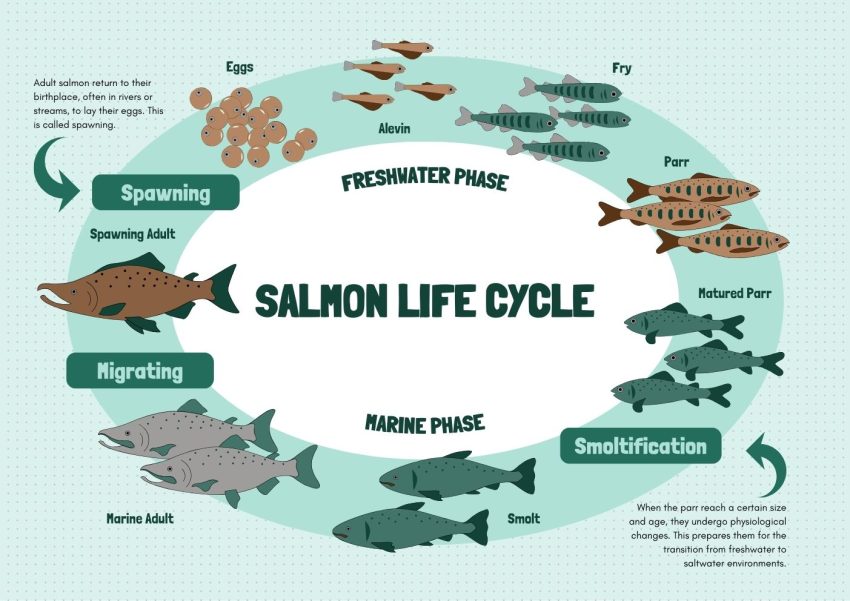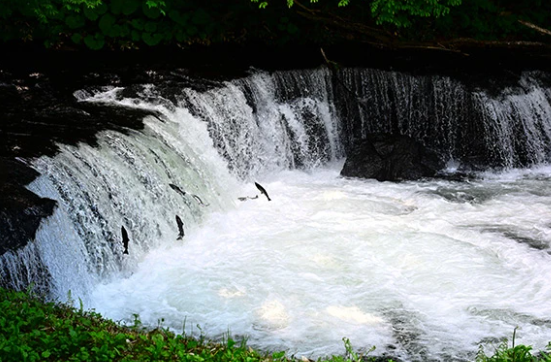|

Photo: phys.org
Mathematical Model Reveals How Environmental Factors Influence Salmon Life Choices
 JAPAN
JAPAN
Tuesday, November 05, 2024, 05:00 (GMT + 9)
Researchers from Tokyo Metropolitan University have developed a mathematical model that illustrates how the evolutionary strategies of organisms are shaped by their environments. Their study focuses on salmonid fish, which face a critical decision: to migrate to the sea and return to spawn or to remain in the river throughout their lives, depending on their individual characteristics.
This research has been published in the journal Population Ecology.
The model effectively predicts how the proportion of salmon choosing to migrate varies with environmental conditions, demonstrating how ecological changes can prompt eco-evolutionary responses.
Salmonids, including species like masu1 salmon, encounter a significant dilemma early in their life cycles. They can either stay in their birthplace for their entire lives or migrate to the sea, where they adapt to saltwater conditions. After migrating, these fish return to the river to lay their eggs.

'Traditional' salmon lifecycle.Photo: courtesy earthhow. Click on the image to enlarge
The existence of these markedly different survival strategies complicates the evolutionary dynamics of salmon populations, especially in relation to environmental interactions. This interplay can influence individual traits and alter the proportion of fish adopting various life strategies.
While such divergent strategies are not uncommon in the animal kingdom, the implications of these choices for population evolution remain poorly understood.
To gain deeper insights into this phenomenon, a research team led by Jun-nosuke Horita of the Japan Weather Association and Assistant Professor Yuuya Tachiki from Tokyo Metropolitan University has created a mathematical model that integrates known traits of the female masu salmon. Their model examines how populations evolve over time based on the availability of alternative life strategies.

Cherry salmon seen jumping out of the water to cross the Sakura no Taki waterfall in Kiyosato, Hokkaido (Takayuki Kakuno)
Female masu salmon have three distinct tactics: they can remain in the river throughout their lives (residents), migrate to the sea after one year (early migrants), or migrate later in life (late migrants).
For simplicity, the researchers focused their model on two strategies: residents and early migrants. They incorporated essential demographic factors, such as the number of eggs laid per individual and their survival rates. A crucial aspect of their model was the inclusion of size distributions, as smaller individuals at an early stage are more likely to opt for migration.
Using this model, the team demonstrated that a stable population could be maintained across a broad range of parameters. Notably, they identified specific conditions under which alternative strategies emerged.

Cherry salmon try to leap up the Sakura no Taki waterfall at the Sharigawa river in Kiyosato, Hokkaido. (Takayuki Kakuno)
Their findings revealed that a river environment with low survival rates, combined with a productive sea environment, significantly increased the likelihood of divergent migratory strategies—an observation consistent with natural conditions.
The researchers also explored extreme scenarios that might otherwise be overlooked. For instance, when the survival rate during the challenging migration process falls below a certain threshold, a dramatic shift occurs, resulting in entire populations becoming residents.
Understanding how populations select different migratory strategies is vital for grasping eco-evolutionary dynamics and, conversely, for assessing how environmental changes affect organism survival.
The team hopes their research can be applied to evaluate and predict the impacts of anthropogenic changes on animal populations.
1.The masu salmon (Oncorhynchus masou), also known as masu (Japanese: マス, lit. 'salmon trout') or cherry trout (桜鱒, サクラマス, sakura masu) in Japan, is a species of salmonid belonging to the genus Oncorhynchus, found in the North Pacific along Northeast/East Asian coasts from the Russian Far East (Primorsky, Kamchatka Peninsula, Sakhalin and Kuril Islands) to south through Korea, Japan and Taiwan. Although generally accepted as a salmon in the West, the fish is actually regarded as a trout in Japan (its most famous native range) as it is the most commonly seen freshwater salmonid in the Japanese archipelago.
editorial@seafood.media
www.seafood.media
|



